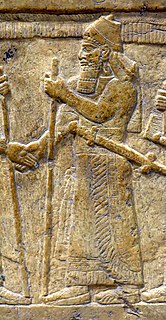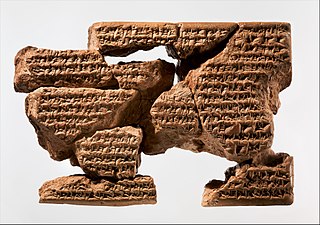 W
WThe Assyrian conquest of Egypt covered a relatively short period of the Neo-Assyrian Empire from 677 BCE to 663 BCE.
 W
WThe Neo-Assyrian Empire was an Iron Age Mesopotamian empire, in existence between 911 and 609 BC, and became the largest empire of the world up until that time. The Assyrians perfected early techniques of imperial rule, many of which became standard in later empires. The Assyrians were the first to be armed with iron weapons, and their troops employed advanced, effective military tactics.
 W
WAdad-nirari III was a King of Assyria from 811 to 783 BC.
 W
WAshur-nasir-pal II was king of Assyria from 883 to 859 BC.
 W
WAshurbanipal, also spelled Assurbanipal, Asshurbanipal and Asurbanipal was the king of the Neo-Assyrian Empire from the death of his father Esarhaddon in 668 BC to his own death in 631 BC. The fourth king of the Sargonid dynasty, Ashurbanipal is generally remembered as the last great king of Assyria.
 W
WEsarhaddon, also spelled Essarhaddon, Assarhaddon and Ashurhaddon, was the king of the Neo-Assyrian Empire from the death of his father Sennacherib in 681 BC to his own death in 669. The third king of the Sargonid dynasty, Esarhaddon is most famous for his conquest of Egypt in 671, which made his empire the largest the world had ever seen, and for his reconstruction of Babylon, which had been destroyed by his father.
 W
WKing of All Peoples was a rarely attested title of great prestige claimed by some of the kings of Assyria. It was one of several ancient Mesopotamian titles explicitly claiming world domination, the others being šar kibrāt erbetti and šar kiššatim. Unlike these other two titles, which had their origins during the Akkadian Empire ~2300 BC and had endured widespread recognition and usage throughout more than a thousand years of Mesopotamian history, the title of šar kiššat nišē appears to have been a later Assyrian invention only used by a handful of kings.
 W
WKing of Sumer and Akkad was a royal title in Ancient Mesopotamia combining the titles of "King of Akkad", the ruling title held by the monarchs of the Akkadian Empire with the title of "King of Sumer". The title simultaneously laid a claim on the legacy and glory of the ancient empire that had been founded by Sargon of Akkad and expressed a claim to rule the entirety of lower Mesopotamia. Despite both of the titles "King of Sumer" and "King of Akkad" having been used by the Akkadian kings, the title was not introduced in its combined form until the reign of the Neo-Sumerian king Ur-Nammu, who created it in an effort to unify the southern and northern parts of lower Mesopotamia under his rule. The older Akkadian kings themselves might have been against linking Sumer and Akkad in such a way.
 W
WKing of the Four Corners of the World, alternatively translated as King of the Four Quarters of the World, King of the Heaven's Four Corners or King of the Four Corners of the Universe and often shortened to simply King of the Four Corners, was a title of great prestige claimed by powerful monarchs in ancient Mesopotamia. Though the term "four corners of the world" does refer to specific geographical places within and near Mesopotamia itself, these places were at the time the title was first used thought to represent locations near the actual edges of the world and as such, the title should be interpreted as something equivalent to "King of all the known world", a claim to universal rule over the entire world and everything within it.
 W
WKing of the Lands, also interpreted as just King of Lands or the more boastful King of All Lands was a title of great prestige claimed by powerful monarchs in ancient Mesopotamia. Introduced during the Neo-Assyrian Empire, the term mātāti explicitly refers to foreign lands, often beyond the confines of Mesopotamia itself, suggesting that the Assyrian king had the right to govern foreign lands as well as his own.
 W
WKing of the Universe, also interpreted as King of Everything, King of the Totality, King of All or King of the World, was a title of great prestige claiming world domination used by powerful monarchs in ancient Mesopotamia. The etymology of the title derives from the ancient Sumerian city of Kish, the original meaning being King of Kish. Although the equation of šar kiššatim as literally meaning "King of the Universe" was made during the Akkadian period, the title of "King of Kish" is older and was already seen as particularly prestigious, as the city of Kish was seen as having primacy over all other Mesopotamian cities. In Sumerian legend, Kish was the location where the kingship was lowered to from heaven after the legendary Flood.
 W
WThe Neo-Assyrian Empire arose in the 10th century BC. Ashurnasirpal II is credited for utilizing sound strategy in his wars of conquest. While aiming to secure defensible frontiers, he would launch raids further inland against his opponents as a means of securing economic benefit, as he did when campaigning in the Levant. The result meant that the economic prosperity of the region would fuel the Assyrian war machine.
 W
WThe Pax Assyriaca, Latin for "the Assyrian peace", was a relatively long period of peace in the Neo-Assyrian Empire during the 7th century .. The term was coined in parallel to Pax Romana. The Neo Assyrian Empire is notorious for its use of brute force to expand and maintain an empire after the Dark Ages of around 911–600 BC. However, their rule brought around a time period known as the Pax Assyriaca. During this time the Neo Assyrian Empire achieved its highest point of success, ranging from Egypt to the West, to the Persian Gulf in the East, and most of the Central Mediterranean area. The economic, political, ideological, and militant development during this period had lasting effects on the events even after the demise of the Assyrian Empire.
 W
WIn the three centuries starting with the reign of Ashur-dan II, the Neo-Assyrian Empire practiced a policy of resettlement of population groups in its territories. The majority of the resettlements were done with careful planning by the government in order to strengthen the empire. For example, a population might be moved around to spread agricultural techniques or develop new lands. It could also be done as punishment for political enemies, as an alternative to execution. In other cases, the selected elites of a conquered territory were moved to the Assyrian empire, to enrich and increase knowledge in the empire's centre.
 W
WSargon II was the king of the Neo-Assyrian Empire from the downfall of his predecessor Shalmaneser V in 722 BC to his death in battle in 705 BC. Though Sargon claimed to be the son of the previous king Tiglath-Pileser III, this is uncertain and he probably gained the throne through usurping it from Shalmaneser V. Sargon is recognized as one of the most important Neo-Assyrian kings due to his role in founding the Sargonid dynasty, which would rule the Neo-Assyrian Empire until its fall less than a century after Sargon's death.
 W
WSennacherib was the king of the Neo-Assyrian Empire from the death of his father Sargon II in 705 BC to his own death in 681 BC. The second king of the Sargonid dynasty, Sennacherib is among the most famous of all Assyrian kings for the role he played in the Old Testament of the Bible, which describes his campaign in the Levant. Other events of his reign which secured his legacy throughout the millennia following his death include his destruction of the city of Babylon in 689 BC and his construction of the last great Assyrian capital, Nineveh.
 W
WShalmaneser III was king of Assyria, and son of the previous ruler, Ashurnasirpal II.
 W
WShalmaneser V was king of Assyria and Babylon from 727 to 722 BCE. He first appears as governor of Zimirra in Phoenicia in the reign of his father, Tiglath-Pileser III. Evidence pertaining to his reign is scarce.
 W
WSammurāmat or Sammuramāt was a female regent of Assyria between 811 and 808 BC.
 W
WShamshi-Adad V was the King of Assyria from 824 to 811 BC. He was named after the god Adad, who is also known as Hadad.
 W
WSin-shumu-lishir or Sin-shumu-lisher, also spelled Sin-shum-lishir, was a usurper king in the Neo-Assyrian Empire, ruling some cities in northern Babylonia for three months in 626 BC during a revolt against the rule of the king Sinsharishkun. He was the only eunuch to ever claim the throne of Assyria.
 W
WSinsharishkun or Sin-shar-ishkun was the penultimate king of Assyria, reigning from the death of his brother and predecessor Ashur-etil-ilani in 627 BC to his own death at the Fall of Nineveh in 612 BC.
 W
WThe state communications in the Neo-Assyrian Empire allowed the Assyrian king and his officials to send and receive messages across the empire quickly and reliably. Messages were sent using a relay system which was revolutionary for the early first millennium BCE. Messages were carried by military riders who travelled on mules. At intervals the riders stopped at purpose-built stations, and the messages were passed to other riders with fresh mounts. The stations were positioned at regular intervals along the imperial highway system. Because messages could be transmitted without delay or waiting for riders to rest the system provided unprecedented communication speed, which was not surpassed in the Middle East until the introduction of the telegraph.
 W
WThe Tell el Fakhariya Bilingual Inscription is a bilingual inscription found on a Neo-Assyrian statue of Adad-it'i/Hadd-yith'i, the king of Guzana and Sikan, which was discovered in the late 1970s. The inscriptions are in the Assyrian dialect of Akkadian and Aramaic, the earliest Aramaic inscription. The statue, a standing figure wearing a tunic, is made of basalt and is 2 meters tall including the base. The two inscriptions are on the skirt of the tunic, with the Akkadian inscription on the front and the Aramaic inscription on the back. The text is most likely based on an Aramaic prototype. It is the earliest known Aramaic inscription, and is known as KAI 309.
 W
WTiglath-Pileser III was a prominent king of Assyria in the eighth century BCE who introduced advanced civil, military, and political systems into the Neo-Assyrian Empire.